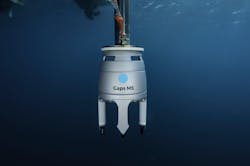iXblue develops second Gaps USBL system for shallower-water subsea tasks
Navigation/positioning specialist iXblue has expanded its Gaps range of ultra-short baseline (USBL) systems for subsea operations support.
The newly developed Gaps M5 is an omni-directional, medium-frequency USBL acoustic positioning system which like the established Gaps M7 does not require on-the-field calibration. It is designed for positioning and vertical/horizontal tracking of subsea infrastructure, from shallow-water to medium water depths (down to 1,000 m/3,281 ft), with a claimed accuracy of better than 0.5% of the slant range up to 995 m (3,264 ft).
The motion sensor embedded within the system is a free-of-export Octans Nano attitude and heading reference system, and is based on the company’s FOG (Fiber Optic Gyroscope) technology, said to ensure stable heading roll and pitch compensation and a true north reference. Gaps M5, with a weight of 14 kg, is smaller and more compact than Gaps M7 (17 kg), features that are said to further facilitate installation and operation. As with Gaps M7, after installing and turning on the system, it is ready for the user to operate.
According to iXblue, when positioning a vessel at a distance of 500 m (1,640 ft), Gaps M5 is accurate up to a maximum of 2.5 m (8.2 ft), and the maximum operating range can be achieved even in noisy conditions. The export-free capability is said to be particularly advantageous for operations in strictly regulated offshore locations. Subsea applications range from tracking of divers, AUVs, ROVs and tow fish tracking to dynamic positioning, long baseline transponder ‘box-in’, subsea structure installation and pipelaying.
Gaps M5 retains the main design features of the M7, but with shorter legs and an overall height around 12 cm (4.7 in.) lower. Its 3D four-hydrophone antenna has different leg lengths to enhance horizontal tracking and the acoustic capability is said to provide maximum aperture, allowing up to 200° omni-directional coverage without the need to tilt the antenna. This is claimed to be a major advantage in shallow water and horizontal tracking conditions, especially when multiple vehicles must be simultaneously located at 360°. The system can also be used for dynamic positioning as an acoustic transceiver, with one beacon in USBL mode or three or more beacons in LBL mode.
Since iXblue introduced Gaps M7 as the first pre-calibrated USBL system in 2005, over 300 have been deployed worldwide. Gaps M7 remains the best option for more complex survey requirements such as subsea multi-beam and laser scan positioning, as it provides an accuracy that can reach 0.06% of the slant range up to 4,000 m (13,123 ft). According to Gary Bagot, iXblue’s Business Developer, Subsea Navigation & Energy Market, many of the company’s clients have confirmed this accuracy at a distance of thousands of meters from the target. One application that benefits from this capability, he explained, is laying a pipeline in a field congested by structures and geohazards. “If the USBL is sufficiently accurate, it can be used to narrow down the optimum corridor for the pipeline. And therefore, unlock shorter safe pipeline routings and decrease sleepers dimensions.”
Gaps M7’s USBL antenna and Phins Fiber-Optic-based inertial navigation system (the latter pre-calibrated at the company’s factory) are combined within the same housing. Its acoustic capabilities, which include wideband signals, are said to maximize performance even in the most problematic conditions, and the 3D acoustic array allows for tracking even at angles above horizontal. Offshore applications range from structure placement to ROV navigation, AUV operations, towfish tracking, cable/pipelay support, touchdown positioning, mattress placement, plough/trenching positioning, rig and anchor moves, riser positioning and OBC node placements for 4D seismic surveys.
Both Gaps M7 and Gaps M5 are based on an open architecture with serial and Ethernet connectivity and Web control command, and according to iXblue both are also compatible with third-party equipment. Even if they operate on the same medium-frequency bandwidth, the two systems can be deployed simultaneously, Bagot added, typically as permanent and temporary subsea positioning systems.
Application wise, the new Gaps M5 is perfectly suited for inshore applications, while Gaps M7 can cover all applications, from inshore to offshore, with ultimate performance.
Among recent applications was a pipelay project where the lay barge already had a permanent USBL system onboard. “However, when the laying operation started, this could not provide the client’s requested accuracy. In this case, the situation was resolved by installing a Gaps on the vessel’s stinger.
“For another project, in shallow water depths, the client wanted to install pipes in 20-m [65.6-ft] sections, one after the other. The operation, involving three divers, and an inspection ROV, was quite challenging in terms of providing an overview of the situation - but the Gaps M7 was able to do it in such noisy environment. In addition, two transponders were installed on each pipe section allowing complete monitoring through iXblue’s Delph Roadmap Software’s 3D view, delivered with every product in the Gaps Series.
“Another client used a Gaps M7 in combination with our 2D/3D visualization software on an offshore construction vessel to ensure safe placement of the structure on the seafloor.” •




